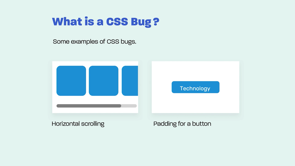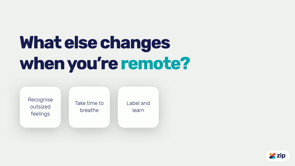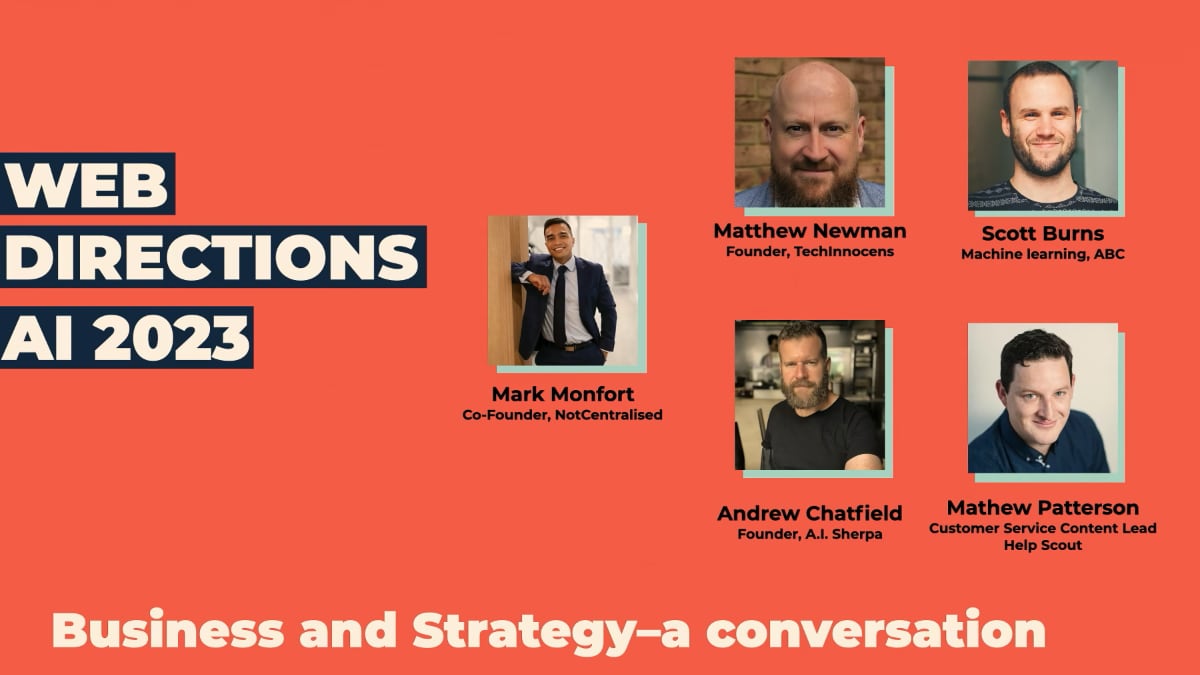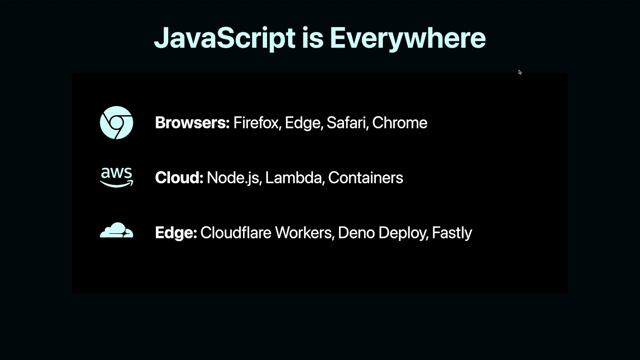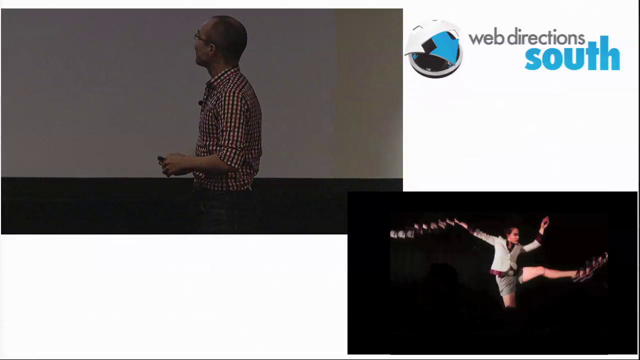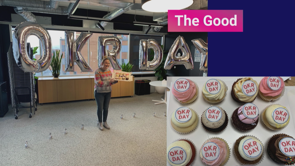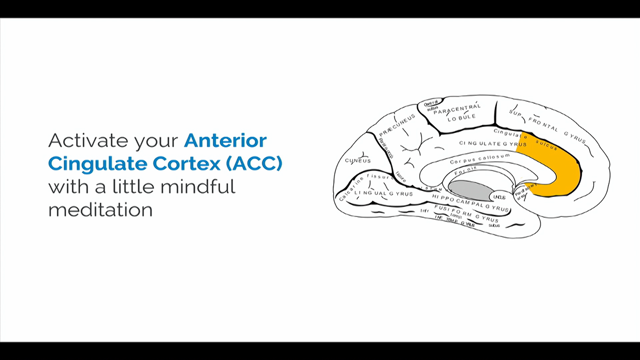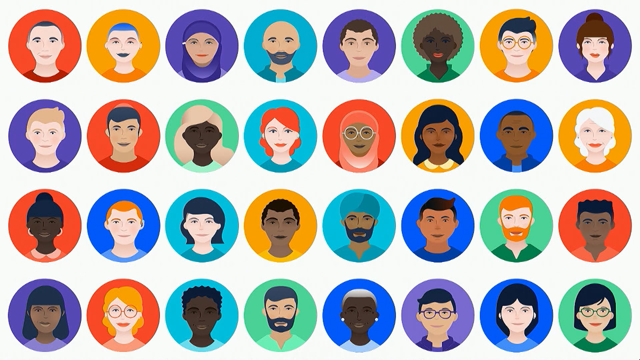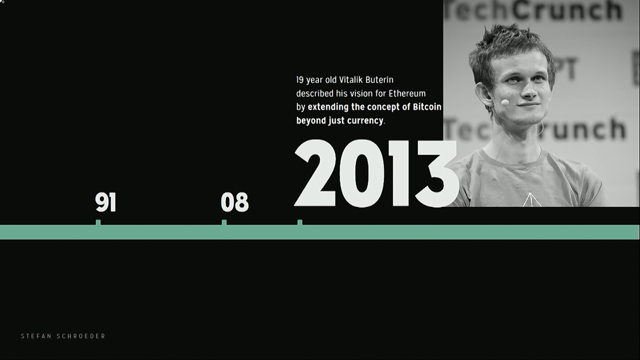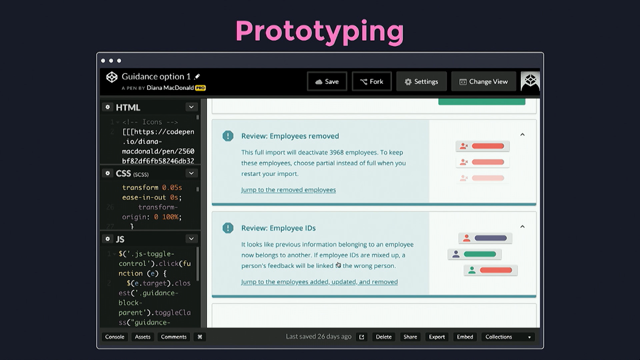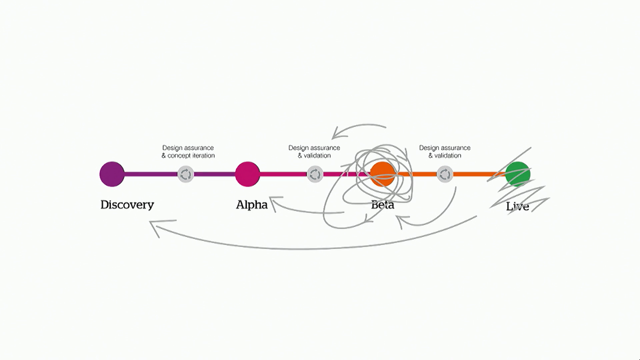
(upbeat, playful melody) - [Kate] Thanks guys.
It's actually really crazy, being here today and presenting, after some of the people who have been talking. Particularly some of the people that I really admire, in my own field, so thanks Lisa for going in front of me (chuckles) that was great.
I'm actually here to talk about a lot of similar things that other people have been talking about.
There were lots of themes that came up that I kept being like, I wanna talk about that, and that, and that.
So, things like using evidence, was really, really big throughout this conference.
Designing for the change we want to see.
And also being aware of our effect on people. So, I wanna talk to you about those things, but, in a slightly different context.
Hands up everyone here who works with, or for government. That's a lot of hands guys.
So you know what I'm talking about.
Government is different.
It's not the same as a private company.
And it can be really challenging to actually do good design work, and see real change when you're working in government.
We've heard from people who work at the DTA or have worked at the DTA.
It's a different experience, because people, they were aligned to doing good work in this type of field. Whereas a lot of other places in government, not so much.
So quite a few of us are involved in the business of understanding people, and designing things that make people's lives better.
And no matter what we call ourselves, whether it's service designer or UX designer, whatever we're actually talking about-- product designer as well, sorry-- We're all trying to actually do the same type of work. I'm Kate, in case anyone missed it.
And I'm really interested in this type of stuff. And I'm really interested in doing it right and doing it better.
I'm not sure there is a right.
So, pretty much everyone here will have interacted with government in some way, as an actual user. And most people, won't have had a great experience, at least once.
When you ask people about their experience interacting with government, and I do, because I am really weird like that, I like to ask people about their experience. They tell you that it wasn't very good.
They usually tell you that it was really hard or confusing. Or they tell you a really long story about their specific circumstances, and why it didn't work. And that's something that we hear really, really often. That it didn't work, at all.
And we need to improve these things because we actually need to deliver services that work for people.
And to do that, we need smart, good people, who are willing to work in government.
So everyone who didn't put their hand up, think about it, like I hope I encourage you (giggles). So, I'm sure most of you have seen this before. Basically, when I work in government, I'm really starting from the ground up.
This is Forrester's CX Pyramid.
And I'm really starting from: Do these products and services meet user needs? A lot of the time they don't.
And that's realistic, like, we have to deal with that. But we need to actually understand our users and do what we can to get them there.
So then after that, we can try working on getting them to be easy, and then enjoyable. So, I actually feel like half my job is pretty much drawing this on a whiteboard over and over again, just trying to get people to get there, and understand that we actually need to build things that work. And the reality is, that for designers in government, that's really hard.
Building things that work, is really, really difficult. There are many cases, where the products we build and the services we design, still aren't actually (audience laughs) meeting users needs.
And it sucks, like it blows up, everyone knows about it. It's not fun for any of the people involved. Whether they're designers or anyone else in the process. And when we do that, when we build the wrong thing, or we build something that doesn't work, it's incredibly wasteful.
This is your money, this tax payer funding. And people in government, I think, are really, really aware of that.
They are aware that they're wasting people's money. But the time frames are just so strict and regimented and the red tape is so intense, they don't know how to get away from that.
So, this isn't happening because anyone's a bad designer or we're not trying, it's happening cause it's just really, really hard to make changes in government when you have so many entrenched processes and power structures, that can just grind change to a halt. Digital transformation is something I hear a lot about in government.
And something the Australian Government is very invested in. We've had people here today, from the DTA, and there's more of you out there in the crowd; You guys are the lucky ones.
You come from somewhere that really believes in Digital transformation.
Digital transformation is about making a profound shift in our business and organisational activities, to actually leverage the changes and opportunities digital technologies can bring to every aspect of our user's lives.
So, I really, actually believe that.
I believe in digital transformation.
I don't see it, in government where I've been working. I don't see that acceptance among the people that I normally work with.
So there's a really low maturity in this type of work. In understanding what we mean, when we say digital transformation.
What results, is often more like, digitization. We get something online, it's a lift and shift, and there's no underlying change.
So, what can we do as designers? As far as I'm concerned, anything.
Every tiny, little change that we can make, we should try. Ethically, I hope, with consideration.
But, the biggest thing there, is try.
It's challenge, it's try and make real change. So, it's not enough to stay really safe in the traditional areas we're used to working in. Like interface design, or analysis of data. We actually need to understand how these big organisations work, their business priorities; How that actually fits into the broader ecosystem. So we need to work with government to understand how their product or service fits into everything else. And we really need to understand the effect of the changes that would have on their customers and their employees. Every time we make an instruction easier to understand, or a form easier to use, that's real change that affects real people.
And it's also an opportunity, to change the business process and thinking behind it.
This is a little, tiny example.
And some of you in the room will be familiar with it. A colleague just sent it to me.
This is something that I'm sure, every designer who looked at went, "oh, that's kind of wrong". But, it's really hard to challenge that when they're working with business people who say, "nah, that's just how it is".
So, they've actually acknowledged in this, that they kind of know it's wrong.
They say, if you don't identify as either male or female, you can discuss this with your delegate after you've registered. Now, to me that feels like a mistake.
And it feels like an opportunity.
It feels like something we can actually challenge and something we can try and effect change on. So, I think, as designers, I think it's our job to try and challenge, for the better, and to try and push for that change where we can. So every tiny win, might not feel like a massive earth-shattering event.
But it doesn't have to be a big-bang change. We can actually do this incrementally.
We can challenge those underlying assumptions. And it can be the sum of all those tiny wins, moving us in the right direction, that gets us to a place where we aren't just focused on making things digital, but on actually improving the services that we're working on. So, a bunch of people have actually gone into this. And particularly Stephanie, yesterday.
So much of what I see, is that problem/validation thinking. So, one of the biggest hurdles that we run into is that even when we're working with government who embrace the idea of UX in their business processes, they're actually bringing us in really late. They want us to validate their solution, as opposed to understanding their problem.
And that leads to so many issues, because, when we get that basic understanding wrong, it affects everyone all across this Country. So, we have so much power in government, in the lives of every day Australians, and people living in Australia.
When we build things, when we get them wrong, it affects people.
We're still trying to deal with the problems from the Centrelink 'robo-debt', where data matching, incorrectly put thousands of Australians into massive debt.
And the position of trust that government holds, is really dangerous.
And as designers, we affect that, every day. And whether you're in development, whether you're building things, whether you're thinking them through, whether you're designing them, we're all part of making these products and services, and we have a real effect.
So that trust, that's not really there right now. That distrust is going, when we see things like this. This is a Senate Committee hearing, where the acting Deputy Secretary in charge of Integrity and Information, who was involved in the 'robo-debt', was basically saying, "No, I think we did good".
He said, "I think we succeeded", and did not care about the user experience. There were so many people involved in that process. We can do better earlier, we can try and stop this, and we can try and do things better.
So, we need to ensure that each new innovation and jump forward, is designed responsibly and that it works.
And, speaking of damage of trust, I'm gonna tell you all that I've actually been spending that last couple of years working at the Australian Taxation Office.
So, it's had a pretty bad time trust wise.
But, my background is across both design and development. And I saw a real opportunity there, to actually work and focus really heavily in user research and testing, and trying to guide these people and work with them, and get them to the right place. So, we're trying to sort of-- well, we were trying to look at, how you can make smarter choices about the things you design. And I was lucky enough, in my role at the ATO to work in a really weird position.
So, we just heard there's sort of, six different roles that Lisa covered.
I'm not sure how we really fit into that one. Kind of a mix between the last three.
So, almost an internal consultancy, almost embedded in the product team, and almost sort of a strategic oversight and central thing. It was a weird place, but it was a really, really great team and a really, really big role.
So, our goal, or what we were told that we should be focusing on, was nice and big; It was...
anything.
So, (chuckles) we were just tasked to improve the user experience wherever we could, however we could, across all ATO products and services. Which was fun (chuckles), there are a few of them. The ATO had just embarked on a digital transformation project, or agenda I should say, called the, "Reinventing the ATO".
Now, they didn't even have an understanding of the overall ecosystem when they went into this. They did not have a central list, or any sort of overall collection of what their different products and services were. It's that siloed in government.
So, we actually had to do a lot to try and pull that together, and work out who all of these people were.
Some of these products, or some of these services that you see up here, may have thousands of people that work on them, like, this is massive.
So, that was fun.
And with so many different projects going on at once, designed to be this sort of like, one-off hit, that would make them digital all of a sudden, they really weren't embracing that digital transformation. And it's something that we've been working on getting them towards.
So, each of those projects was based around a pre-defined solution.
I had a waterfall timeline.
And they're really far away from actually transforming their business practises.
That wasn't even something they were really considering at the time.
I actually helped form a really awesome team. Multidisciplinary team of generalists, experienced interface and content designers, devs, user researchers, data analysts, and usability testers.
Basically it was awesome.
We started really, really small, so it was just me and one other person, and we just grew, which was fun.
We gradually scaled up into a couple of different teams. The off-shoots of them are here, today, which is really nice to see.
We were sort of tasked to just provide guidance and resourcing, and whatever we could do, to product, service, and project teams across the ATO, and a few other departments. I don't know really, how well we managed to do that but I'm really hoping we did make a good difference. We leveraged the DTAs service design and delivery process and tried to advocate for the digital service standard at every opportunity.
Often working with projects that had decided they didn't need to be assessed, or were actively avoiding anybody knowing about them, so, that was really fun.
It felt like we kept stumbling back on that same problem, where we got a project at the solution stage and then had to desperately intervene.
And sometimes days before they were due to go live. So, we know the problem with using (mumbles) research and testing methods to validate solutions, is that so often we haven't asked the right questions. Some of the work that I am most proud of at the ATO, is stuff that you will never see.
It's things that we stopped.
We might have sent them back into discovery. We might have killed it, altogether as an idea because it just wasn't actually going to serve people or meet their needs.
So, for a little while I started to feel like we're a bit of a project hit squad.
Because every time we engage with people, we were just barer of bad news.
It wasn't a popularity contest by any means, like it was not the funnest, but it was such valuable work because the amount of waste that would've happened, if that hadn't been intervened in, is really extreme. But it was also a super positive process.
Because we felt like it was our mission to advocate and educate about what people could do. And in practise, we worked with them, actively embedded in their teams, to work through the cultural and foundational changes and the different business processes and practises that they would need to adopt, to start working in this way, and seeing real change. So we had to teach them things, like, failure is okay. And we had to really reinforce that.
And we celebrated failure, because failure is learning. Failure is showing us, that we learned something new. And failure also, shows us that we learned that before we built the entire thing.
So, yesterday, we heard about, 'Move fast and break things'. We were more like, 'Fail fast and learn things', before you make those huge mistakes, that affect millions of people.
So what I found, as designers, is that it wasn't enough to have creativity, experience, or knowledge, as much as I would like it to be.
What worked for us, was data and evidence, wherever we could use it.
But also, taking people along on that journey, working with them, and not just trying to bash them over the head with our evidence, but actually taking them through the process, getting them to the point where they understood the validity of an evidence-based approach. I think that's a big theme that I've heard about a couple of times today, so, it's actually really good to hear that echo from a few different people. So, we did a lot of different types of evidence. As I said before, we had data scientists work in the team, but we also had generalists, or designers, or devs, who started to learn more about evidence, about statistics, about data science, so that we could work out other ways of trying to draw this information out, and find better insights to give to the people we were working with. And like Stephanie said yesterday, we needed to deliver that evidence to stakeholders in ways that they needed and that they understood. So it was a really big part of what we've done. Working with stakeholders, treating it like user research. Finding out what they need from us, what they care about, what's coming up politically and what's on their radar. That's a really realistic thing, that you need to cope with in government, and you need to be able to leverage. Is that going to go next? So, luckily the ATO recognised that they had a massive trust issue, and they haven't fixed it yet, like I'm sure non of you love the ATO, but they've actually made it a corporate priority to address trust.
Because they've decided that if they don't have willing participation from Australians and from people who pay tax in Australia, they will actually have so many more costs, so much more responsibility and resourcing requirements, they've equated this to productivity.
So that was actually an awesome KPI for us to work with. We could actually say, sweet, UX is on their radar, they need to give people an experience that meets their needs, they need to build up trust with their users.
But, as designers that work with people and care about people, that sort of, KPI positioning does put us in a really weird place.
First, we're trying to really humanise things and build empathy and understand real people and think about how we're affecting lives, but then we're trying to un-huminize it and go the other way, and say, this is about costs and resources, we'll show you a productivity increase.
So, that's a weird balancing act, it's not necessarily a fun place to be but it's something you need to recognise.
Little examples like this.
Like, let's say we take a screen that an internal staff member uses, and we simplify their user experience.
We take a task that used to take 30 minutes and we now make it take 15 minutes.
For us, we feel good, we're designers, we like to improve their process, we like to make things better for them, you know, yay! For exec, we increase their productivity by 100%. They like those numbers, they like nice, big vanity stats like that.
We could show effect, we could show productivity and cost and resourcing, across real employees, and show real cost savings.
But when you are dealing with real employees with real salaries, what does it mean when you actually make their job take half as long as it used to? So, in the reports we put forward, we use nice words, things like, re-tasking; We could re-task those resources, cause that's what we called them, not people.
But realistically, this is something we have to consider. And particularly, as part of digital transformation, where we are really making big changes, and big effects on old systems that used to exist, that might not. So, we're talking, fundamental changes to business practises.
And we're also talking, those considerations that are coming up in things like, AI and Automation but are equally as relevant to these tiny improvements. So, as Lisa was just talking about, I actually wanted to talk to you about some forms. And thankfully, I don't have to get into the detail because she's just explained how terrible some of those forms experiences are.
I had a really weird experience, where I was starting a discovery project into a forms experience at the ATO, at the same time, as being a customer who needed that form. That was fun.
So the ATO had actually done a really weird thing at that time.
They'd taken away shopfronts, so you could no longer physically access those forms, or go and talk to somebody and find out how to do that.
And they'd also stopped stocking forms at post offices and newsagents.
So that was a part of this big, go paperless push, when they hadn't worked out what the other side of that would look like, or whether it was even right to take away the paper options.
So, now, if you wanted one of these forms-- and these are forms that people use every day. When you start a new job you need to fill out a TFN declaration.
Every person who has been employeed in Australia does this. You can't get that anymore.
You had to go and log in on this portal, that you had to find through Google, and you had to make an account, you had to order it using a number that you had to know somehow, and then it got posted to you about two weeks later. So, I had to actually cheat.
I couldn't get my task done, and I was trying to research this, as a user I could not get access to that form. I actually just requested a sample internally and that's the only way I could fill that out in time for my job, which sucks.
So we found out some really disturbing things while we were doing that discovery project: Just about, how badly prepared their forms were for a digital transformation.
And the type of thinking that we heard before about, is this even the right way to do it? Should there be a form? How does this work, should they be digital? None of that had been done.
There's still massive, massive strides to go. But we actually managed to get some really, really good data and evidence pulled together.
So, while the broader organisation was saying, you know, digital this, digital transformation, at this area, was just absolutely beginning. They had not made any progress at all.
And they were very, very far away from going paperless. By removing the easy access to paper forms, they'd actually broken the experience for a huge amount of people who could no longer get access to them at all. So, everybody here, all of you, you are legally required to meet your obligations to the Australian Taxation Office. But they aren't actually making it possible for you a lot of the time.
They're trying to improve it, but sometimes it's just broken.
This information, that we gathered in this discovery project, actually contributed towards a Senate inquiry into the taxpayer engagement with the tax system.
So my bosses may not have loved that, but that was UX at work, being taken seriously by government, which was really, really good to see. That evidence we gathered, convinced the ATO to prioritise this key user interaction.
And it's now getting addressed.
So, not only is further discovery and early prototyping prioritised and happening, but we actually got the opportunity to look at that terrible portal that we couldn't get through earlier, and fix that pretty much straight away.
So, we put together, UX performance metrics, around baselining the idea of that portal and how that worked; We're just trying to work out, like, what did we need to do to meet users' needs. It's a very, very lightweight thing, it came together very quickly but essentially, we assessed the current experience against what we thought we needed to do to meet their needs, and it's no secret, it failed on pretty much every criteria.
Now some of that, is gonna be our own bias. We are people, bias exists.
But we did test this, and validate this with a lot of different types of people.
And we could not find almost any (mumbles) case where the portal as it stood, was actually useful for people, and working.
Internally, at the ATO, people knew this.
They joked about it, they moaned about it.
But nobody thought they could changed it.
They hadn't considered that it actually could be changed, until we challenged it.
So, it actually enabled us, to make some smart choices about what we were doing.
We selected a different option that we could use. It was a really simple, quick pace of testing, we used as a heuristic.
So this particular one was tested with internal people in the area, against the same criteria, as opposed to going out for user testing.
But it gave them the beginning stages that they could look at.
For an ICT Procurement to get something better in the short term.
So that's just a really quick example of UX with evidence effecting change quickly, and challenging something that people didn't previously think could be changed.
So, the forms still suck.
They haven't fixed that.
These guys off the back here, will get to have that fun job for the next, however long, yay. I'm actually jealous, I would love to be working on that (laughs), but there's a foot in the door now, is the point. Designers can challenge, they can get involved. They can use evidence, and they could make a change to do good, and actually make real changes that affect people.
So, thanks guys, that's me.
(audience applauds) (upbeat, fun melody)
